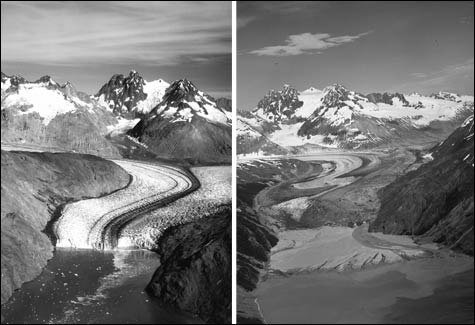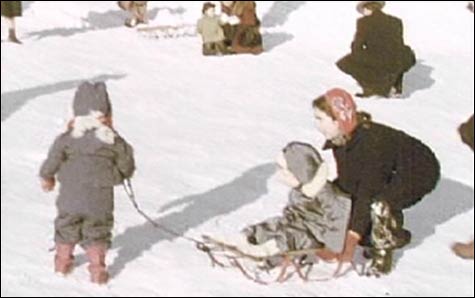
HOT SPOT: Alaska’s Nunatak Glacier as photographed by Bradford Washburn in 1938 (left) and
David Arnold in 2005 (right).
|
“Human beings just can’t affect climate that much,” David Arnold remembers Bradford Washburn telling him in 2005.
This was no ordinary global-warming doubter. Washburn — who died in Lexington this past January, at age 96 — was the founding director of Boston’s Museum of Science and a renowned mountaineer and photographer whose images had appeared in Life and National Geographic. Beginning in the 1930s, he shot stunning black-and-white photos of mountains and glaciers by hanging out the sides of airplanes with his camera. And he amassed a collection of some 8000 photographs. But when Arnold asked him in 2005 how global climate change might have affected his old haunts, Washburn figured things would look pretty much the same.
He was wrong.
Arnold, a long-time Boston journalist, had begun wondering what changes global warming might have wrought on these icy landscapes. In June of 2005, he traveled from his home in Milton to Alaska. He hired planes and helicopters to fly him and his 4x5 view camera over the same rocky vistas Washburn had scouted decades before — Hugh Miller Glacier, Nunatak Glacier. What Arnold found astonishes. Only mud was left where Washburn had seen the great frozen river of the Hugh Miller Glacier in 1940. The Nunatak Glacier that Washburn shot in 1938? “Here it is dead. It’s just withered away.”
Arnold’s project, which partners Washburn’s before photos with his own after photos (some of these appeared in the Boston Globe and Harvard magazine and at NPR on-line last year), provides powerful evidence of how global warming is changing the planet. “Unless you look at Washburn,” he tells me, “you really don’t have a benchmark for what this ice looked like three-quarters of a century ago.”
Now, Arnold’s juxtaposition of before and after is one of the standout projects of the new and burgeoning territory of global-warming art. At this early stage, you can’t yet point to many great works, but it’s an area that’s attracting more and more artistic effort. And global-warming art has already played a significant role in pushing forward the debate about climate change.
The two most often cited examples of global-warming gallery art come from alums of Providence’s Rhode Island School of Design. Shown at Andover’s Addison Gallery and at RISD in 2005, Alexis Rockman’s Manifest Destiny (2004) is a 24-foot-long mural that depicts a freaky future New York flooded by global climate change. Connecticut artist Tavares Strachan’s poetic, melancholy 2006 sculpture The Distance Between What We Have and What We
Want (Arctic Ice Project) is a giant block of Arctic ice preserved in a solar-powered refrigerator.

COLD AS A THING OF THE PAST? That’s the question Joe Milutis’s video Line of 32 asks.
|
The most prominent example of global-warming art is, of course, Al Gore’s 2006 documentary film An Inconvenient Truth, which has to be judged as one of the most significant examples of political art of the past century, up there with Upton Sinclair’s novel The Jungle and Rachel Carson’s non-fiction book Silent Spring, for its success in bringing public attention to the problem of global climate change. (I’m using the term “art” broadly to describe any creative endeavor, from painting to journalism to boat building.) Along with Elizabeth Kolbert’s reports on global warming that began appearing in the New Yorker in 2005 and Jared Diamond’s 2004 book Collapse, a study of how societies mismanage their relationships with the environment, An Inconvenient Truth sparked much of the global-warming art now appearing in galleries and museums.
The Institute of Contemporary Art opened its new building in South Boston last December with an exhibit featuring Jane Marsching of Roslindale and three other finalists for its Foster Prize, which honors “a Boston-area artist of exceptional promise” with $25,000. Marsching, the most prominent local artist addressing global warming, presented Arctic Listening Post, which featured riffs on the Arctic and climate change including goofy invented photos of explorers clowning in the Arctic and video appropriated from the US government’s North Pole Webcam.
Marsching’s most promising piece was Climate Commons. She and assistants built a table and stools from scraps recycled from the construction of the new ICA building. There visitors could sit at laptops to read a blog about “climate change, sustainability, and the Arctic” authored by Marsching and collaborators including an Episcopal priest, a journalist, a scientist, a comedian, and activists. The blog was successful as a clearing house for links to on-line eco-information, but I’d hoped for more discussion and new ideas arising from cross-pollination among the heterogeneous contributors. Still, it shows how global-warming art crosses boundaries among art and science and journalism, and how object making can lead to public discussions.